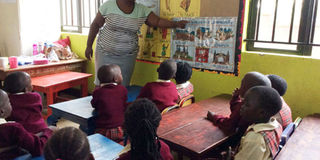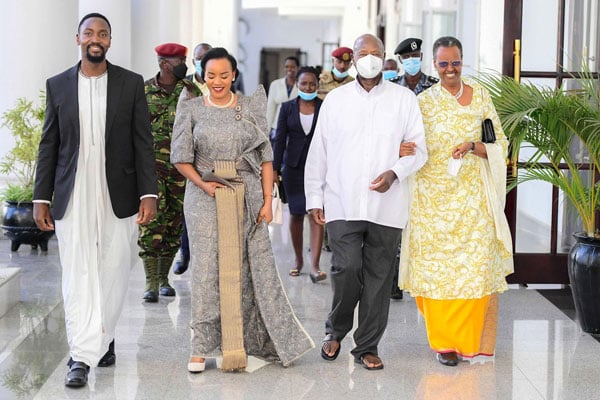How pupils with Special needs can learn in mainstream classes

Some of the pupils with special needs at Hill preparatory primary school in Kampala attend a lesson. Some of the pupils eventually get integrated in the mainstream classes. PHOTO BY JOAN SALMON
What you need to know:
- The Salamanca Statement of 1994 states that those with special educational needs must have access to regular schools within a child-centred pedagogy capable of meeting these needs. But how far are our schools incorporating them?
Having done inclusive education for 20 years, as of October 20, Ambrose Lukusa Kibuuka, the head teacher of Hill Preparatory, says special needs conditions vary in degree; some can do classwork while others cannot.
“Those that can do classwork have a mild degree of the disorder,” he explains.
These include those with dyslexia, cerebral palsy, autism, and attention disorder. Kibuuka, however, notes that there are incidences where those with dyslexia perform better than the other children. For example, they had a set of twins who scored Aggregate 7 in Primary Leaving Examinations a few years ago.
Children with dyslexia have trouble reading accurately and fluently. They may also have trouble with reading comprehension, spelling and writing. In June 1994 representatives of 92 governments and 25 international organisations formed the World Conference on Special Needs Education, in Salamanca, Spain. They agreed on a dynamic new statement on the education of all disabled children, which called for inclusion.
Preparing them
But how do you prepare children with learning disabilities to join mainstream classes? Julius Oyeyo, an occupational therapist at Tunaweza Children’s Centre, posits, “We teach them basic things such as numbers, colours, letters and shapes.”
He, however, reiterates that all that is dependent on the severity of the condition. Their condition can determine the level of work you can give them. One may easily learn 1-100, while another may only be comfortable with one to five.
Oyeyo adds that they follow the ministry of Education curriculum for special needs children. During assessment, at Tunaweza, children are clustered in classes both functional and academic.
“In the functional class, you will find children that are learning how to handle pencils, shade, and sing, improve on concentration and behaviour. However, the academic class handles those that have graduated from the functional class. These do numeracy and literacy,” he reveals.
A visit to the class shows that mostly the sessions are one-on-one except in a few instances, say where the goal is on socialisation. The teachers do this because the method that might work for one pupil may not work for another.
“If we find that the child can take on more than what is taught here, we refer them to mainstream schools,” he adds. He notes that most children with hydrocephalus have their cognition intact, making it possible to do more. Tunaweza have and continue to work with schools such as International School of Uganda, Lubowa and Daffodils Primary School.
Integration
Integrated classrooms can be a challenge for students and teachers alike. But with proper planning, support, and a few simple strategies, teachers can ease the strain and serve every student better.
For instance while referring these pupils, their referral forms contain recommendations with residual issues that the child might have which are continually addressed by a therapist. Kibuuka cites an example that a child might have issues with behaviour yet have the ability to handle mainstream learning.
“They will have an occupational therapist visit them daily to help them improve their behaviour,” Kibuuka notes.
“While we put them in the mainstream, we give them special attention to enable them cope,” Kibuuka adds. The teacher constantly records the kind of support being given.
The teachers keep in constant touch with the special needs centre in cases such as Hill’s where it is also run by the school, because a one day report may not be conclusive. They also do continuous assessment to see how each child is coping. In case they are not coping, David Muyanja, Hill Preparatory School director of studies, adds that they reassess to find suitable placement for them.
Extra time
They go through the same class time, however, Muyanja says they are allowed extra time with teachers to familiarise themselves more with whatever was taught. They are also allowed to move out or take breaks a bit more frequently than other pupils. Nonetheless, the teachers try to treat them like the rest, lest they take advantage of it.
Recapping on the issue of assessment, Kibuuka says sometimes, upon re-assessment, the children are taken back to the centre for life skills.
Other than not fitting in, he says complexity of concepts in further classes is reason to take these children to the special needs centre for skills development.
He explains that the starting concepts are usually simple and the mode of teaching is musical, which appeals to them. However, as they go higher, the demand for their attention increases as concepts get harder, making it hard for them to catch up.
Muyanja also adds that parents may sometimes not understand these concepts and insist on their children staying in the mainstream. However, when the classroom concepts get harder than they can handle, you cannot do much, it is futile to keep the child there. There are things that they can learn but there is a level beyond which they cannot. For example, it would not make sense to continue forcing a 19-year-old child to learn something of a four-year-old.
That said, inclusive learning provides a wealth of learning opportunities for both instructors and their students.
Teaching them
Ambrose Lukusa Kibuuka, the head teacher of Hill Preparatory, points out that special needs children need help in catching up. Therefore, the teacher prepares the work so that content delivery is eased, even for one that is taking long to understand a concept.
• Others need to sit next to the teacher for prompting to keep doing what is required of them.
• Some might need to sit near a fellow pupil that is faster in catching up – child-to-child support.
• He also mentions that the support needed varies from subject to subject.
Are teachers trained?
Stuart Robert Oyesigye, a lecturer of Special Needs Studies at Kyambogo University, says inclusive education has not taken root in Uganda due to few teachers with the knowledge and skill on how to teach these children. The lack of these makes them build a defence mechanism against these children, simply because they cannot address their needs.
Due to the ignorance, the teachers cannot make study materials for the children. For example, Oyesigye says a blind child would benefit from tactile study material. However, when the teacher is ignorant about this, the child will not be helped.



